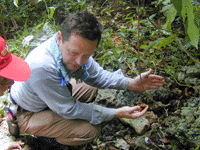 Rudi Diesel
expounds on the "snail-shell crab" at Windsor in June, 2000. He has
been studying these crabs in Jamaica since 1986 and is presently
preparing a video presentation on Cockpit Country research. The
"snail-shell crab" (Sesarmae jarvisi) is an example of
special adaptation to the "waterless" karst terrain and a
remarkable example of "brood
care" in the Cockpit Country. The females raise their families
in the shells of dead snails. They actually turn the shell over to
put the aperture downwards so that rain and dew does not flood
their "house". They then carry dew water to fill the shell up to
its overflow so that the larvae (which still have gills) can
survive. Of course, as Rudi says (see Bibliography), the first remarkable
adaptation of these crabs was to learn to live in fresh water
instead of their original salt water. no doubt this occurred during
the millions of years when Jamaica slowly submerged and then
reemerged from the sea (see Formation of
Jamaica). Another example of brood care Rudi discovered is the
bromeliad crab (Metopaulias depressus), which raises its
young in the water-filled bromeliads. The mother manipulates water
quality by removing detritus , circulating water to oxygenate it
and carrying empty snail shells into the bromeliad as both a
calcium source and a pH buffer.
Rudi Diesel
expounds on the "snail-shell crab" at Windsor in June, 2000. He has
been studying these crabs in Jamaica since 1986 and is presently
preparing a video presentation on Cockpit Country research. The
"snail-shell crab" (Sesarmae jarvisi) is an example of
special adaptation to the "waterless" karst terrain and a
remarkable example of "brood
care" in the Cockpit Country. The females raise their families
in the shells of dead snails. They actually turn the shell over to
put the aperture downwards so that rain and dew does not flood
their "house". They then carry dew water to fill the shell up to
its overflow so that the larvae (which still have gills) can
survive. Of course, as Rudi says (see Bibliography), the first remarkable
adaptation of these crabs was to learn to live in fresh water
instead of their original salt water. no doubt this occurred during
the millions of years when Jamaica slowly submerged and then
reemerged from the sea (see Formation of
Jamaica). Another example of brood care Rudi discovered is the
bromeliad crab (Metopaulias depressus), which raises its
young in the water-filled bromeliads. The mother manipulates water
quality by removing detritus , circulating water to oxygenate it
and carrying empty snail shells into the bromeliad as both a
calcium source and a pH buffer.
Molecular evidence shows that Jamaican land crabs evolved from a
single adaptive radiation from a marine ancestor that invaded
terrestrial habitats only 4 million years ago (Schubert et al,
Nature vol 393, 28May,98 see Bibliography), so that it is possible that
M. depressus should be placed in the same genus as the other
Jamaican endemic crabs, of the genus Sesarma.
Rudi is based at the Max Planck Institute in Germany and you can check out his excellent site at http://www.Science-Media.de
We value your feedback and comments: